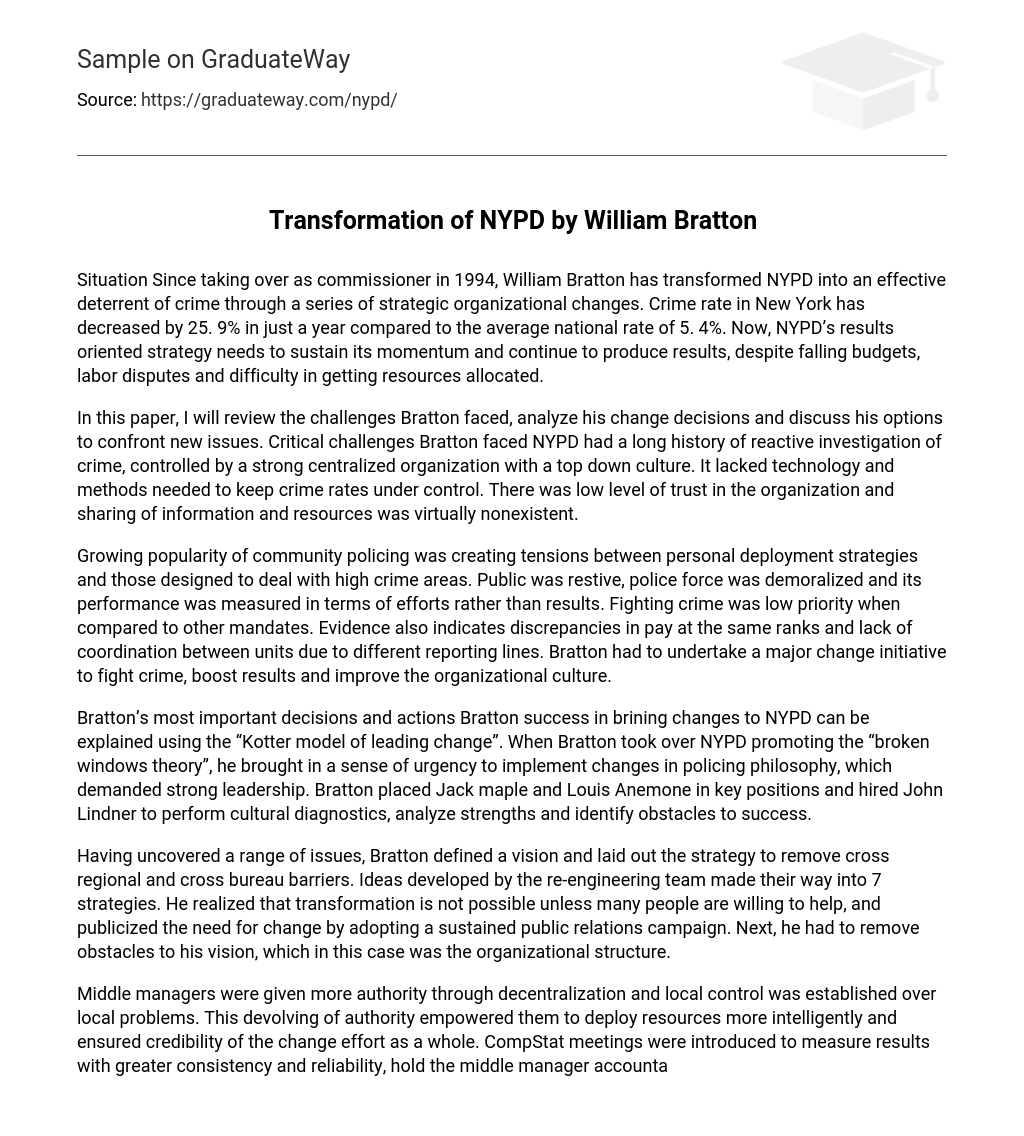Situation Since taking over as commissioner in 1994, William Bratton has transformed NYPD into an effective deterrent of crime through a series of strategic organizational changes. Crime rate in New York has decreased by 25. 9% in just a year compared to the average national rate of 5. 4%. Now, NYPD’s results oriented strategy needs to sustain its momentum and continue to produce results, despite falling budgets, labor disputes and difficulty in getting resources allocated.
In this paper, I will review the challenges Bratton faced, analyze his change decisions and discuss his options to confront new issues. Critical challenges Bratton faced NYPD had a long history of reactive investigation of crime, controlled by a strong centralized organization with a top down culture. It lacked technology and methods needed to keep crime rates under control. There was low level of trust in the organization and sharing of information and resources was virtually nonexistent.
Growing popularity of community policing was creating tensions between personal deployment strategies and those designed to deal with high crime areas. Public was restive, police force was demoralized and its performance was measured in terms of efforts rather than results. Fighting crime was low priority when compared to other mandates. Evidence also indicates discrepancies in pay at the same ranks and lack of coordination between units due to different reporting lines. Bratton had to undertake a major change initiative to fight crime, boost results and improve the organizational culture.
Bratton’s most important decisions and actions Bratton success in brining changes to NYPD can be explained using the “Kotter model of leading change”. When Bratton took over NYPD promoting the “broken windows theory”, he brought in a sense of urgency to implement changes in policing philosophy, which demanded strong leadership. Bratton placed Jack maple and Louis Anemone in key positions and hired John Lindner to perform cultural diagnostics, analyze strengths and identify obstacles to success.
Having uncovered a range of issues, Bratton defined a vision and laid out the strategy to remove cross regional and cross bureau barriers. Ideas developed by the re-engineering team made their way into 7 strategies. He realized that transformation is not possible unless many people are willing to help, and publicized the need for change by adopting a sustained public relations campaign. Next, he had to remove obstacles to his vision, which in this case was the organizational structure.
Middle managers were given more authority through decentralization and local control was established over local problems. This devolving of authority empowered them to deploy resources more intelligently and ensured credibility of the change effort as a whole. CompStat meetings were introduced to measure results with greater consistency and reliability, hold the middle manager accountable for their actions and encourage inter-bureau coordination. Cost efficiency was attained through introduction of new technology.
Bratton defined short term goals (like 10% reduction in 1994) and pushed the organization hard to attain these goals. In two years, there was a significant decline in crime and improved job satisfaction and morale within NYPD. Bratton’s options to confront the challenges In 1996, Bratton faced several challenges including budget cuts, labor wage disputes, restrictions on deployment of resources and inability to reward performance, all of which threatened to hamper the momentum of changes. His relationship with Giuliani is a key factor that needs to be highlighted.
Kotter model suggests that leadership coalition needs to grow over time, and more people need to buy into the system. Major changes are not possible without support from head of the organization. Furthermore, since NYPD is constrained by its public sector nature and its budget primarily controlled by the mayor, Bratton should strive to get Giuliani bought into his long term plans. NYPD employees are represented by a group of powerful, but fragmented, unions. Bratton should find partners in the union leadership, who would uphold and support his vision of change.
He needs to educate them that though legislation shifting contract dispute arbitration responsibility would result in larger salary increases, it would prompt additional budget cuts leading to further job reductions. Labor contracts and civil service statutes have made it difficult to reward performance in spite of effectiveness. To tackle this, Bratton should institute a new rewards system, which is a key to attaining organizational congruence. To eliminate corruption, he should promote a culture that eliminates organizational fear nd self protection. Lastly, Bratton needs to consolidate improvements and produce more change. Initial changes need to sink more deeply into the organizational culture, a process that could take years. As the model suggests, he should use the credibility gained from his short term wins to tackle bigger problems facing NYPD. He should show people how his new approaches have helped improve overall performance of the organization, and ensure that the next generation of top management personifies the initial years of change.





